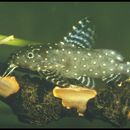en
names in breadcrumbs


The Mochokidae are a family of African catfishes known commonly as ‘squeakers’ and ‘upside-down catfishes.’ These common names refer to some unusual habits of certain members of the large genusSynodontis. The name squeaker refers to the fact that, when agitated, many species in the genus are capable of making a squeaking noise by stridulation of the pectoral spine against the pectoral girdle (Jubb, 1967); stridulation is also apparent inMochokiella payneiand some species ofAtopochilus.
Even more peculiar is the habit of some species ofSynodontisthat are known to swim upside-down. This habit seems to be correlated with feeding while upside-down at the water’s surface (Bishai & Abu Gideiri, 1965b), but upside-down catfishes will rest and swim in the inverted position on a regular basis. Chapman et al. (1994) showed that an upside-down posture near the surface also facilitates respiration in poorly oxygenated water. While the genusSynodontispresents the most well-known species with their fascinating behaviors and natural histories, the family is actually much more interesting when taken as a whole.
Mochokid catfishes are currently restricted to the freshwaters of Africa, but are nearly ubiquitous in the habitable waters of the continent. A high degree of morphological diversity allows mochokid catfishes to inhabit some of the fastest flowing streams and cataracts to the widest and deepest stretches of the Congo River. Mochokids also inhabit the massive African rift lakes like Tanganyika, Victoria and Nyasa. The greatest diversity of mochokids almost certainly occurs in the Congo River and its numerous tributaries, but they are also found in many of the rivers and lakes of western Africa, southern Africa, eastern Africa and in the Nile. Like a handful of other catfishes, some mochokids are known to swim in mid-water; other members of the family are primarily benthic. Likewise, some mochokids shoal while others are rather solitary. As a rule they are most active during the night, but they can be found hiding amongst plants, logs and other submerged structure during the day.
The Mochokidae are a family of catfishes (order Siluriformes) that are known as the squeakers and upside-down catfish (although not all species swim upside-down). There are nine genera and about 200 species of mochokids.[1] All the mochokids are freshwater species originating from Africa.[2]
They have three pairs of barbels, with the nasal barbels absent; sometimes, the mandibular barbels may be branched.[2] The lips are modified into a suckermouth in Atopochilus, Chiloglanis, and Euchilichthys.[2] The adipose fin is usually very long. The dorsal and pectoral fins have spines that are usually strong and with a locking mechanism.[2] They range in size up to 72 cm (28 in) SL.[2] This group contains many popular species among aquarists, such as Synodontis nigriventris, Synodontis angelicus, and Synodontis multipunctatus.
The Mochokidae are a family of catfishes (order Siluriformes) that are known as the squeakers and upside-down catfish (although not all species swim upside-down). There are nine genera and about 200 species of mochokids. All the mochokids are freshwater species originating from Africa.
They have three pairs of barbels, with the nasal barbels absent; sometimes, the mandibular barbels may be branched. The lips are modified into a suckermouth in Atopochilus, Chiloglanis, and Euchilichthys. The adipose fin is usually very long. The dorsal and pectoral fins have spines that are usually strong and with a locking mechanism. They range in size up to 72 cm (28 in) SL. This group contains many popular species among aquarists, such as Synodontis nigriventris, Synodontis angelicus, and Synodontis multipunctatus.